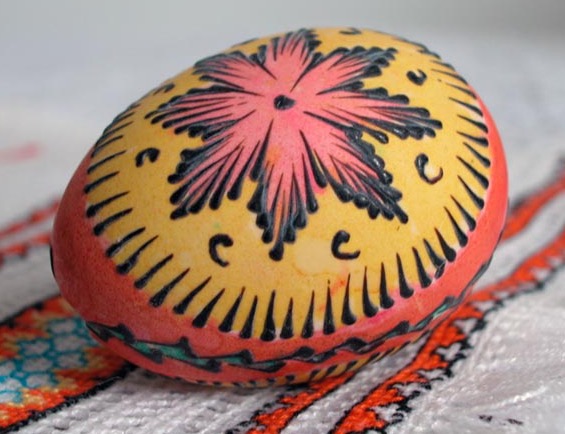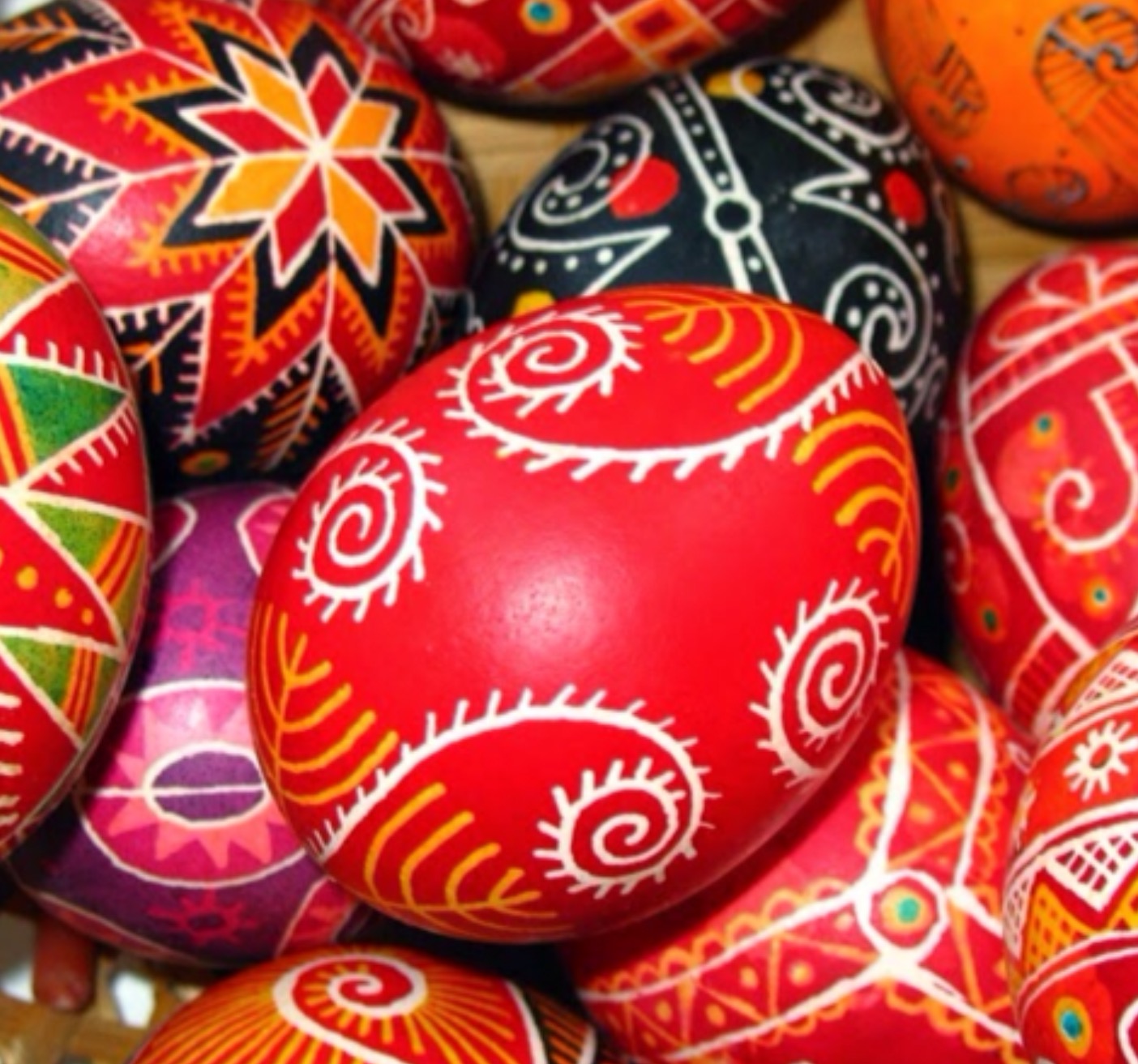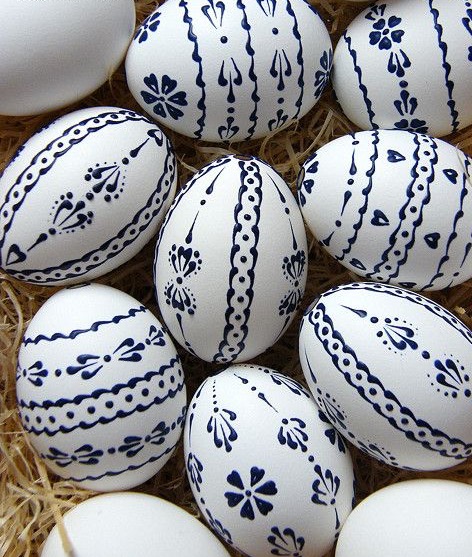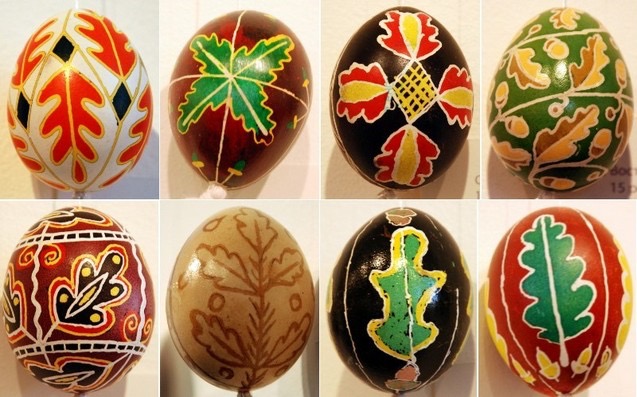 We want to tell you about a great miracle of Ukrainian handicraft; it is called "pysanka".
We want to tell you about a great miracle of Ukrainian handicraft; it is called "pysanka".
Since the ancient times in Ukraine pysankas were revered more than anything else, they were widely painted with great excitement both by children and adults. The design of pysankas has been varying for many centuries as they were nor merely drawings but a unique writing, aesthetical code, which you, my dear reader, will be able to understand after reading this book and studying its paintings.
Many, many years ago a man was living in a close relation with a surrounding world being full of wonders. A man perceived all the objects and phenomena rather poetically existing in the harmony with nature and its laws. He embodied those objects in his imagination believing in their existence according to certain laws and being full of mysterious and powerful strength. The Earth, the Water, the Fire, the Sun and the Stars became alive.
But there always was something obscure. People could not understand the rain, the storm, and the drought, the lightning, the winter, the spring, tire summer and the autumn. They just appeared from nowhere and somehow influenced people's life. In order to get along with nature a man started to draw symbolic signs, started his artistic list for the power of nature. We can observe the very symbolic signs on pysankas, carpets, pottery, jewelry, embroidery and other masterpieces of national handicraft.
The patterns on pysankas can be quite colourful and each colour has the meaning of its own: red is the incarnation of everlasting energy; yellow symbolizes heavenly bodies: the moon and the stars, it is also the symbol of harvest and welfare; green is the symbol of nature resurrection: blue means the sky and water; brown is the embodiment of the earth and a rich harvest; black colour is the combination of all colours that is the reason to treat it as the symbol of the Earth and prolificacy on a pysanka; as well as red colour it is closely connected with the beyond.
THE SUN
 For you the powerful Svarog we cry,
For you the powerful Svarog we cry,
You are the god of mighty sky,
Make the haven for us clean
So the birds to sun can fly,
Take us, dear, by the hands,
Show us those far, far away lands.
We would like to play the game
And meanwhile to praise your name!
Pysanka was the symbol of the spring sun which is the source of light, warmth and life since the old times. Using the sun (solar) symbolism on pysankas is very popular all over Ukraine. The sun is shown like a circle or an octagonal star sometimes with curled up tips called "the sun" or "spiders". "Svarog", "trident", "three horn" and "curled horns" belong to the most ancient images of the sun. These symbols picture the sun as a sky fire having been praised and celebrated by people since the old days.
The pysanka decorated with solar signs used to possess miraculous power. It could work wonders and ask the sun for protection against ailments and an evil eye for its owners.
THE STARS
 Like the children are the stars,
Like the children are the stars,
Sun is their mother,
They don't want to go to sleep
On a cloud together.
Not obedient are you -
I will learn your singing,
You are drinking morning dew
While my mother's sleeping.
The images of the stars on pysankas are called "ruzha" or "a rose". According to the place they are depicted, they can be called "a side rose" or "an up rose". They can also be named "a full rose" or "a multipettaled rose".
The stars are the symbol of heavenly bodies; these are the Sun and the Moon which were of a great importance in people's life being the source of light and warmth. The glorifying of the Sun birth after winter "death" was the basic essence of the Easter celebrations in the ancient times. In Christianity the revival of everything alive is closely connected with the image of Jesus Christ who symbolizes eternity and salvation through his resurrection. The image of the star-rose is one of the favourite ones in Ukrainian pysanka handicraft. We can often observe the image of the star having eight or sometimes six rays on a pysanka.
THE WATER
 Oh, the water deep, deep water,
Oh, the water deep, deep water,
Of a stream is running by,
When in summer it is hotter
Water's coolness flowers try,
If I want to have refreshment
I will ask a small grey bird: —
Bring me please a drop of water
Songs of small birds will be heard.
The pysankas with the images of water are rather various, but the most widely spread are those named "a rake", "curls" or "the endless". On the "rake" pysanka we observe stylistic image of a uiangle like a cloud or a single line giving the beginning to the sky dew flower streams moistening and giving life to everything. Wann spring streams of water falling down from the heaven to the earth are the stylistic image both of the Water and the Sun being not only the source of light but of warmth too. Dots mean the seeds of the same new life to grow. The image of water depicted like straight horizontal lines, zigzags or waves was often used on domestic objects from the Stone Age, it signifies the ancient roots of this symbol.
THE ENDLESS
 Let my drawing be a part
Let my drawing be a part
Of the Pysanka's domain
Brought us from Trypillya's day
When the dragons were smart,
Let it be old tales narrator
As the winter frosty drawing
For the endless sign is showing
That it is the harvest maker.
This sign on pysankas is usually called "a leech", "spiders", and "a snail", "a shell", "a swing", "a break", "curls" or "the endless". Sygmalike images are often used on the ceramics of Tripillya culture of about 5-3 millenniums B. C. The image of the endless is closely connected with the symbol of Sky Dragon which used to fly up and down on the horizon carrying the sun or the moon by turns.
The symbol of "the endless" is the incarnation of everlasting, eternal movement. This sign is also connected with the cult fertility.
THE CROSS
 All the villages and towns
All the villages and towns
Glorify and mesmerize
Silent and eternal beauty
Of the Holy Cross of Christ.
He protects with mighty power
All the people of the world,
He will lead us to salvation
Through the darkness by Ins word.
Don't forget the Cross will ask you
To confess and to forgive,
Each will tell: — Christ's resurrection
Can the love and gladness give.
One of the oldest symbols in the world is the cross. Since the ancient times it has been denoting the Earth and its four parts. People often called this design "a turtle".
This symbol has rather multiple meaning. The combination of two lines, the vertical one representing the heaven and masculine origin and the horizontal one representing the earth and feminine origin, meant the beginning of new life, everything eternal.
A branch with leaves or a fir depicted near the cross signified the everlasting rebirth.
The cross is also the simplified image of Jesus Christ.
THE FISH
Be thou healthy as the water is.
Be thy home full of the Holy Bliss,
Do we love the ancient words,
Do we sing when get to work.
Sign of Fish, so bright as ever.
Will stop shining for us never,
Have a look, try out your will.
Draw on eggs the fish whieh's still.
Since the ancient times the image offish was connected with the symbol of health for the water element was the habitat offish.
The greeting "Be thou healthy as the water is" has been frequently used in national folk-lore till our times.
With the adoption of Christianity the fish became the symbol of Jesus Christ. Early Christians being severely prosecuted by the Roman Emperor depicted Jesus Christ as a dolphin.
THE DOTS
 Dropping dots, dropping dots -
Dropping dots, dropping dots -
seeds are falling down
Getting into black rich soil.
And the sky with dots of stars
I like more than ever.
Silently the tears are dropping
From the cloud on our life -
It is Jesus' Mother weeping
For her child beloved and kind.
The images of dots are often used on pysankas and the meaning of this symbol is rather various. Dots symbolize grain or the first sprouts; sometimes they can mean heavenly bodies i.e. the stars brightly covering the horizon. A dot can also remind a smaller image of a bird egg. The dots on pysankas symbolize the presence of the sun light. There is one more meaning of the dots - they denote the tears of the Virgin she has dropped on a pysanka crying for her son.
Sometimes the decoration of Easter eggs can be done with single dots. This technique is called "dotting". They say the first pysankas to have been decorated with the very dots.
THE OAK
How many, many leaves you have
My ancient, curly, dark oak-tree
And if I start to count stars -
So less they are and not so green,
How powerful and strong you are
In songs you can be praised
My ancient, curly, dark oak-free
Like a forest knight you've raised!
One of the ancient images on Ukrainian pysankas was the oak leaf. The oak is the sign of masculine strength, firmness, endurance and longevity.
The very oak was the symbol on the main god of the Eastern Slavs during a heathen period. The drawing of oak-leaves is one of the most beloved motives pictured on the Easter eggs.
The oak is valued for the hardness and wet resistance of its wood used for making domestic objects or in house building. The oak bark was also used for skin scrubbing and as a medicine as well. Houses were decorated with oak leaves on Green Holydays.
The full-dress of all the generals all over Europe is obligatory decorated with symbols resembling oak leaves not by chance.
Kiev & Ukraine Private Tour Guides
The poetry written by the poet Mykhaylo Kamenyuk



